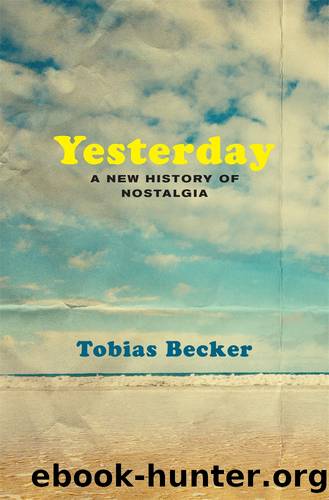Yesterday by Tobias Becker

Author:Tobias Becker
Language: eng
Format: epub
Publisher: Harvard University Press
From Revivalism to Presentism
âWhatâs new in fashion?â asked Suzy Menkes in 1993, advising her readers, âYou should be asking, Whatâs old? ⦠After a decade that celebrated all that was new, shiny and sleek,â she continued, contradicting the self-characterization of the 1980s as a decade of revivals, âold is beautiful.â254 After the 1950s revival in the 1970s and the more limited 1960s revival in the 1980s, pop culture critics did not have to be clairvoyant to expect one of the 1970s in the 1990s. âItâs 1988âand the 1970s are back!â satirist Tony Hendra duly obliged the expectation as early as 1988.255 âThe 70âs (Stayinâ Alive) Wonât Die (Stayinâ Alive),â the New York Times declared in 1991, noticing how those âwho actually took part in the decade that taste forgotâ rather hoped to forget the decade, whereas âmany of todayâs 70âs revivalists were pre-teen-age, if not toddlers.â256 Like preceding revivals, that of the 1970s was mainly driven by young people, proving wrong those who had prophesied that the 1970s were too marked by revivalism to ever be revived themselves.
The influence of the 1970s was especially apparent in fashion, both in haute couture and, perhaps even more so, in streetwear, where it became more conspicuous as the decade went on, especially with the return of such iconicâand subsequently widely ridiculed and reviledâ1970s styles as bell-bottom trousers and platform shoes.257 There was also no dearth of films and television series set in the period, such as Dazed and Confused (1993), Jackie Brown (1997), Boogie Nights (1997), Velvet Goldmine (1998), and That â70s Show (1998â2006). âBehold! The 1970s! Which happened again in the 1990s,â observed Michael Bracewell, looking back on the decade as it ended.258 For the critic Chuck Klosterman, nostalgia for âthe unexperienced seventiesâ was âcentral to everythingâ about the 1990s. But the longing was of a different sort, not like âpeople of the seventies had longed for the fifties. It was not nostalgia for a time that was more wholesome. It was nostalgia for a time when you could relax and care less.â259 And yet, the prominence of acceleration in the thinking about nostalgia in the 1970s suggests that it was already understood as a yearning for a past retrospectively construed as slower than the present.
In general, both the revival and how it was described followed a well-established formulaâwith the important difference that the 1980s trend of coexisting and overlapping revivals became even more salient: there was never just one style coming back at any one time. In addition to revivals of more recent styles, the 1950s and 1960s lingered on long after the initial revival had ended or were revived again.260 The âsixties are swinging once again,â observed the Guardian in 1995.261 âLondon swings! Again!â concurred Vanity Fair in 1997, referring explicitly to the by now legendary 1966 Time article about âSwinging London.â âThereâs more than a little self-conscious similarity between Londonâs 60s and 90s,â it proceeded, âbecause Britons in their 20s and 30sâthe current tastemaking generationâhave studied their forebears well.â262
Download
This site does not store any files on its server. We only index and link to content provided by other sites. Please contact the content providers to delete copyright contents if any and email us, we'll remove relevant links or contents immediately.
Cecilia; Or, Memoirs of an Heiress — Volume 1 by Fanny Burney(31352)
Cecilia; Or, Memoirs of an Heiress — Volume 3 by Fanny Burney(30950)
Cecilia; Or, Memoirs of an Heiress — Volume 2 by Fanny Burney(30907)
The Great Music City by Andrea Baker(21621)
We're Going to Need More Wine by Gabrielle Union(18087)
Bombshells: Glamour Girls of a Lifetime by Sullivan Steve(13120)
Pimp by Iceberg Slim(12947)
All the Missing Girls by Megan Miranda(12776)
Fifty Shades Freed by E L James(12464)
Talking to Strangers by Malcolm Gladwell(11909)
Norse Mythology by Gaiman Neil(11902)
Crazy Rich Asians by Kevin Kwan(8373)
Mindhunter: Inside the FBI's Elite Serial Crime Unit by John E. Douglas & Mark Olshaker(7850)
The Lost Art of Listening by Michael P. Nichols(6485)
Enlightenment Now: The Case for Reason, Science, Humanism, and Progress by Steven Pinker(6414)
Bad Blood by John Carreyrou(5782)
The Four Agreements by Don Miguel Ruiz(5533)
Weapons of Math Destruction by Cathy O'Neil(5048)
We Need to Talk by Celeste Headlee(4881)
